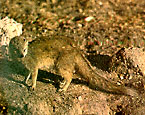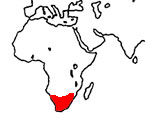|
Yellow
Mongoose
(Cynictis penicillata) #61-766 |
||||
|
|
Physical
characteristics and distribution
|
|
The Yellow Mongoose is a small mammal averaging about 1 lb (1/2 kg) in weight and about 20 in (500 mm) in length. As many as twelve subspecies of Yellow Mongoose have been described. In general, the Yellow Mongoose has lighter highlights on the underbelly and chin, a bushy tail, and a complete lack of sexual dimorphism. Southern Yellow Mongooses are larger, have yellow or reddish fur, longer fur, and a longer tail with a characteristic white tip. Northern subspecies tend towards smaller size, grey colouration, a grey or darker grey tip to the tail, and shorter hair more appropriate to the hotter climate. The Yellow Mongoose is carnivorous, consuming mostly arthropods but also other small mammals, lizards, snakes and eggs of all kinds. The Yellow Mongoose is primarily diurnal, though nocturnal activity has been observed. It lives iin colonies of up to 20 individuals in a permanent underground burrow complex. When frightened, the Yellow Mongoose will growl and secrete from its anal glands. It can also scream, bark, and purr, though these are exceptions, as the Yellow Mongoose is usually silent, and communicates mood and status through tail movements. The mating season of the Yellow Mongoose is between July and September, and it gives birth underground between October and December, with no bedding material, in a clean chamber of the burrow system. Usually, two offspring are produced per pregnancy, and they are weaned at 10 weeks, reaching adult size after 10 months. A member of the mongoose family, it lives in open country, from semi-desert scrubland to grasslands in S Angola, Botswana, South Africa, Namibia, and SW Zimbabwe. |
|
Description
of the brain
|
|
Animal
source and preparation
|
|
All
specimens collected followed the same preparation
and histological procedure.
|
Other Related Resources (websites and publications)


